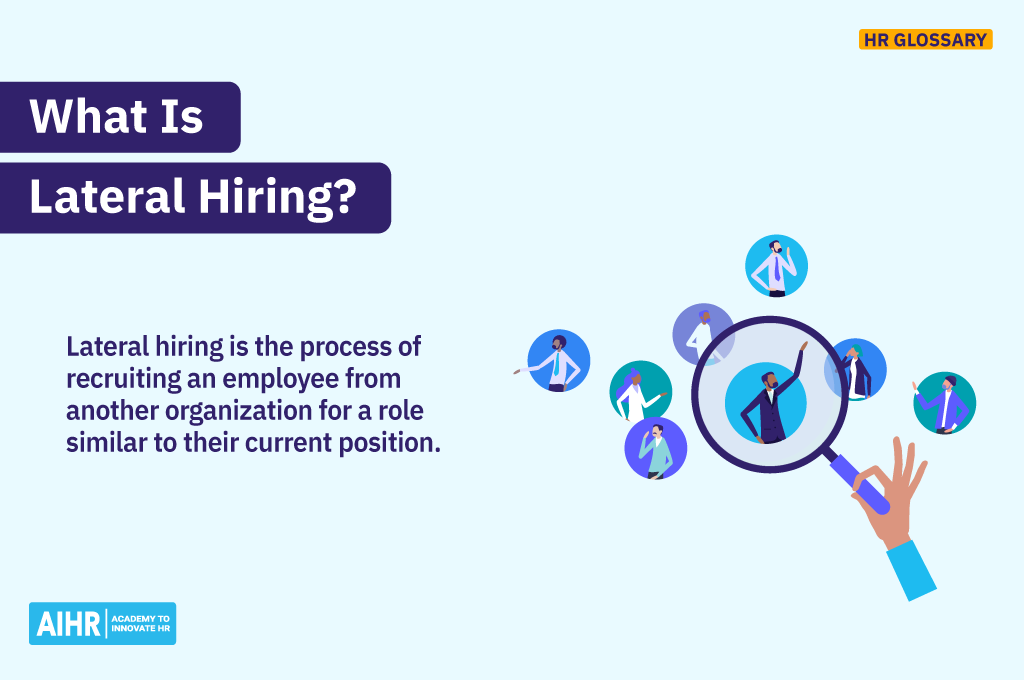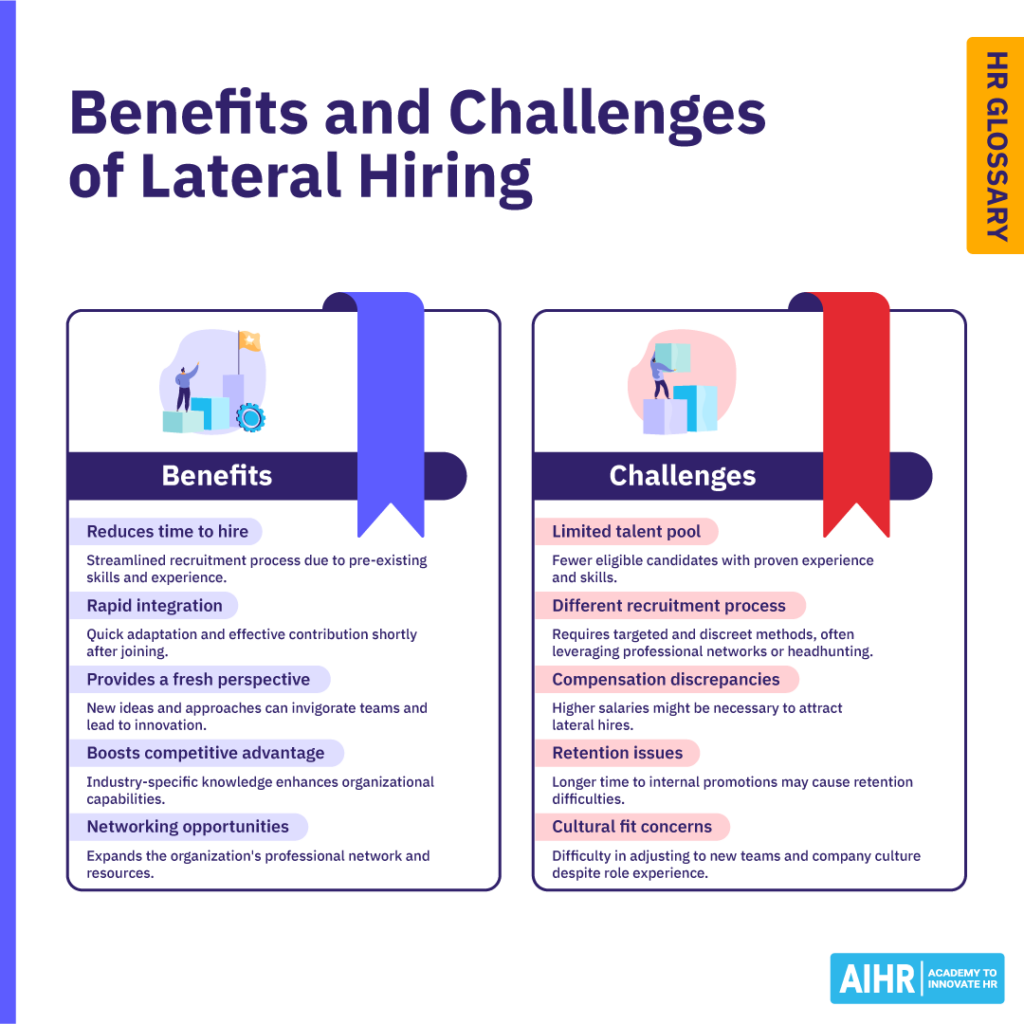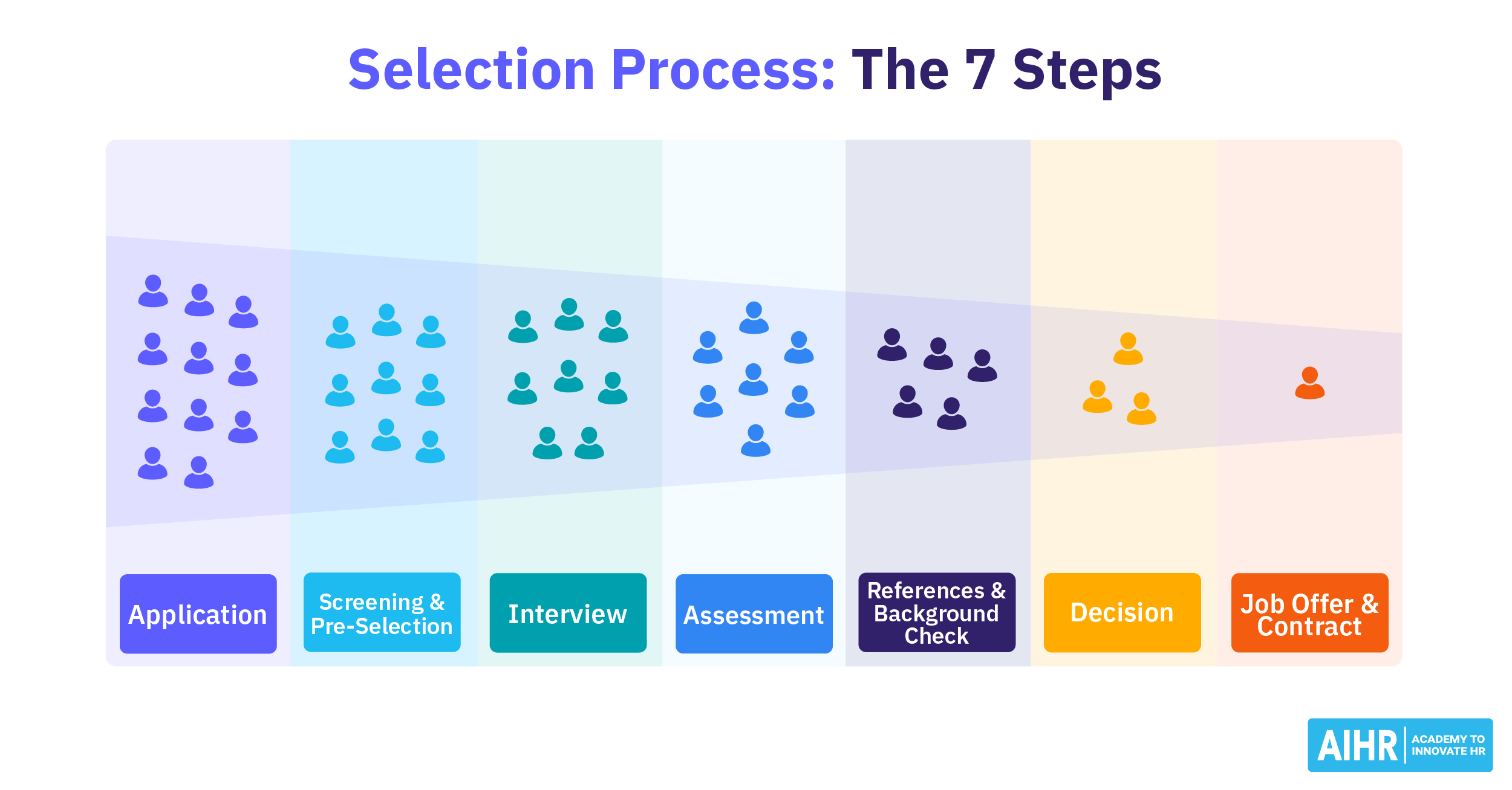Lateral Hiring
Lateral hiring meaning
Lateral hiring, also known as lateral recruitment or specialized hiring, is the process of recruiting an employee for a role similar to their current position from outside the organization. Lateral hires usually have the proven experience, skills, and industry knowledge required for the role. Lateral hiring can also happen within a company when employees move to a role at the same level but in a different department or function.
HR professionals typically use lateral recruitment to fill positions quickly, bring in new perspectives, and fill skills gaps. Since the new hire already has relevant experience in the role, lateral hiring can help reduce the time and costs associated with traditional recruiting methods.

Lateral hiring examples
Here are a few examples of lateral hiring:
- An HR manager from one company joins another as an HR manager to fill a vacancy quickly and bring fresh ideas to employee relations and policies.
- A senior graphic designer moves from one organization to another in the same role to help enhance the new company’s branding with their proven design skills.
- An IT specialist transfers from one department to another within the same company to apply their technical expertise to a different business unit.
- A sales manager is hired by a competitor to take on the same position and leverage their existing client relationships and market knowledge.
- A financial analyst joins a new company at the same level to bring their analytical skills and industry experience to the organization.
Strengthen your hiring strategy with lateral hiring
Lateral hiring brings in experienced professionals who can contribute immediately, helping companies fill key roles faster and gain fresh insights.
In AIHR’s Strategic Talent Acquisition Certificate Program, learn how to identify top talent, refine your sourcing strategy, and leverage lateral recruitment to meet business needs effectively.
Benefits and challenges of lateral hiring
Benefits
- Reduces time to hire: Since lateral hires already possess the experience and skills for the role, the recruitment process is faster. Recruiters and hiring managers spend less time assessing basic competencies, which helps minimize the time it takes to fill a vacant position.
- Rapid integration: Lateral hires typically have relevant experience and skills that align closely with their new roles, allowing them to adapt quickly and contribute effectively shortly after their arrival.
- Provides a fresh perspective: Bringing someone in from a different organization can infuse fresh ideas and new approaches to problem-solving, which can invigorate teams and lead to innovative solutions.
- Boosts competitive advantage: Individuals hired laterally often bring valuable industry-specific knowledge that can enhance the organization’s capabilities and provide competitive advantages.
- Networking opportunities: These hires often bring extensive professional networks that can open up new business opportunities, partnerships, and access to further talent pools.
Challenges
- Limited talent pool: Selecting candidates with proven experience and skills in the position can reduce the number of people eligible for the role.
- Different recruitment process: Lateral hiring may require you to be more targeted and discreet than traditional methods. HR professionals might need to leverage their professional networks or headhunting agencies to attract top candidates, especially if they’re from competitors.
- Compensation discrepancies: Enticing lateral hires to leave their existing role may require offering them a salary increase, which may be higher than average for the role/industry.
- Retention issues: Retaining these hires can become difficult if they stay in one position for too long, as it may take them longer than other employees to be considered for internal promotions.
- Cultural fit concerns: Although they have prior experience in the role, lateral hires may not always easily fit into new teams or adjust quickly to the company culture.

Lateral hiring vs. campus hiring
Lateral hiring and campus hiring are two common approaches to talent acquisition, each offering distinct advantages and disadvantages. Understanding these differences helps companies align their recruitment efforts with their specific needs, goals, and long-term strategies. Here is an overview of the key differences between the two:
Definition
Hiring experienced professionals from other organizations for a similar role and job level.
Recruiting fresh graduates or interns directly from educational institutions.
Experience level
Experienced professionals with the relevant skills and knowledge for the position.
Recent or fresh graduates with limited or no professional experience.
Salary expectations
Potentially higher due to being highly qualified and having a proven track record.
Generally lower since suitable roles are mostly entry-level.
Onboarding time
Shorter, as less training is needed due to existing knowledge and skills.
Longer, as more comprehensive training is needed due to a lack of work experience.
Retention
May be less likely to stay if there’s little opportunity for promotion beyond the lateral position.
May stay longer if provided with a clear career path with advancement opportunities.
Lateral hiring vs. vertical hiring
Lateral hiring involves recruiting employees from similar positions in other organizations, bringing in individuals who have comparable experience and expertise. This approach is often used to fill roles quickly, as lateral hires typically require minimal training and can immediately contribute to the team. Lateral hiring can also happen internally, when individuals change positions within the organization to transition to a role on the same level but in a different department or function. An example would be a Marketing Manager transitioning to a Product Manager role.
Vertical hiring refers to promoting employees within the organization to higher roles or positions. Vertical hiring helps maintain organizational knowledge and culture while rewarding loyalty and good performance. However, it may require more investment in training and development to prepare employees for their new roles.
In summary, lateral hiring is ideal for bringing in immediate expertise, typically from outside the organization, while vertical hiring focuses on internal growth and promotion from within. Each approach has its benefits and is used depending on the organization’s needs and long-term goals.
The lateral hiring process
Lateral hiring requires a strategic approach to attract experienced professionals efficiently. This is how lateral hiring typically works:
- Determine your company’s needs: Focus on identifying the desired skill set, competencies, industry knowledge, and prior experience needed for the vacant position. If it cannot be filled internally, determine if the role would truly benefit from a lateral recruitment process.
- Develop a targeted job description: Unlike a traditional job posting, ensure the job description is specifically targeted at lateral hires. Even if it is not published widely or publicly, outline the essential experience and skills required, emphasizing that the role is exclusively meant for a lateral hire. Be specific about how candidates can prove their track record and success in a similar role.
- Identify potential candidates from multiple sources: Unlike a traditional candidate search, lateral recruitment may involve reaching out to your professional network or engaging a headhunter or recruitment agency to attract highly qualified candidates already working in similar roles. If your budget is limited, focus on continually building your talent pool through industry events, conferences, and online professional communities.
- Discreetly approach candidates: When evaluating, considering, or applying for a lateral hire position, be discreet in approaching potential candidates. This helps them maintain their privacy and avoids alerting their current employers.
- Conduct a targeted interview process: Use a tailored interview process to allow candidates to demonstrate that their current experience meets the lateral position’s specific requirements. Remember to also assess how well the lateral hire would fit within their new team and the company culture.
- Offer a competitive compensation package: Lateral hires may need extra incentives to make the move, so ensure your offer is highly competitive. Consider additional perks like signing bonuses, relocation packages, and flexible working arrangements.
- Provide a tailored onboarding program: Design a tailored onboarding plan that highlights what makes your organization unique. This will show lateral hires that although they are making a lateral move, they are also gaining new growth and development opportunities.
HR tip
When onboarding lateral hires, assign them an internal mentor or peer from day one. This helps them quickly navigate the company’s culture, build key relationships, and apply their existing skills more effectively in their new environment.









